Return to main Astrophotos page
Calstar 2019 was again held at Lake San Antonio, from Sept. 25-29. Until a few days before we left, the weather forecasts were predicting a lot of clouds, but this changed to a more favorable outlook at the last minute. The weather ended up being not bad overall. Wednesday night was warm and clear the whole night. Thursday night seemed humid, and the sky clouded over around 1am, and on Friday night the sky clouded over around 11pm (the seeing was quite good in the early evening, though, and we saw great detail on Jupiter and Saturn). Saturday night was quite cold, but clear until we stopped around 3am. We went back and forth between three devices for taking data - Charlie's HP laptop, and Kathy's old netbook and newer Windows tablet. They have various pros and cons with respect to battery life and portability/weight. We have also been using Ski Safari at Calstar the past few years for locating objects and managing observing lists. This time we ran it on Kathy's 12" iPad Pro.
This year we were back in the main Calstar camping site, which is the South Shore overflow campground. The lake level was modest, but much better than a few years ago around the time Lake San Antonio was closed due to drought. There was enough water for the jetskiers and boaters. Unfortunately, all of the marina amenities (excluding the rental cabins, but including the general store) are now closed, and with Monterey County's lake management plan still under review, it's uncertain what the future will bring in terms of changes to the facilities and concessions as well as seasonal park closures. We did get to stop by Lake Nacimiento (in search of ice cream) as well as Paso Robles, where we had time for lunch and a bit of sightseeing after the previous night ended early due to clouds.
|
|
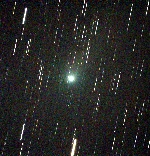 |
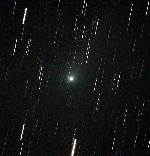 |
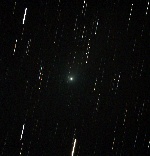 |
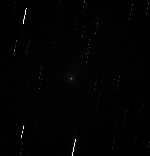 |
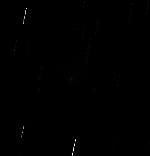 |
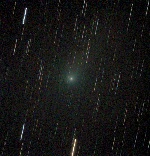 |
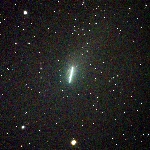 |
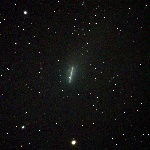 |
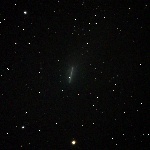 |
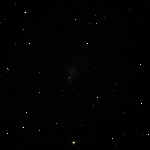 |
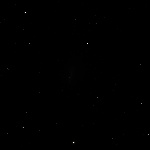 |
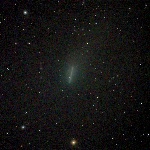 |
| Imax=1 | Imax=2 | Imax=4 | Imax=16 | Imax=64 | Nonlinear |
SBIG ST-4K, 1200s total exposure 9/26/19 Lake San Antonio, CA
This comet was near its closest approach of approximately 0.5 A.U. and moving rapidly through the constellation Pegasus on the night of Sept. 25-26, 2019. Initially I tried a 5-minute exposure with the normal autoguiding procedure, using a background star, but the comet moved too much during the exposure. Instead, I took a sequence of 40 30-second unguided exposures. These exposures could then be combined through image registration, using either the comet (top row) or the background stars (bottom row). The stars do not always appear as symmetric points because of tracking errors during the 30s exposures, a drawback of skipping the autoguiding. The comet appears to have a bright nucleus with a small, circular cloud surrounding it, but not much of a tail.
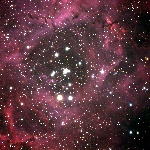 |
| Imax=1 |
SBIG ST-4K, 1800s total exposure 9/25/19 Lake San Antonio, CA
The Rosette Nebula in Monoceros includes an open cluster (NGC 2244) and regions of surrounding nebula (NGC 2237-2239, 2246). This object is somewhat difficult to image at Calstar because it rises late. On the night of Sept. 25-26, it seemed high enough to start imaging at around 4:30am. Not long after I started, a thin crescent moon rose in the east, but the sky seemed dark enough to continue for a while. The dark clouds in the upper part of the image are quite interesting, including some rather small objects (globules? Bok globules?). The estimated distance to the Rosette Nebula is 5200 light years (compared with 1340 ly for the Orion Nebula).
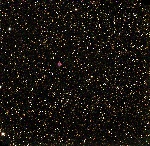 |
| Imax=1.35 |
SBIG ST-4K, 1200s total exposure 9/26/19 Lake San Antonio, CA
This is a planetary nebula in Aquila with a relatively low surface brightness but an interesting color contrast. A bluish central star seems to be visible.
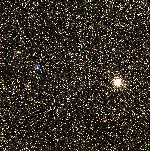 |
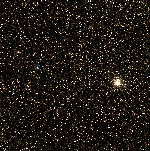 |
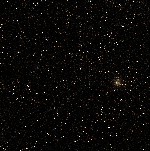 |
| Imax=1.50 | Imax=3 | Imax=12 |
SBIG ST-4K, 735s total exposure 9/27/19 Lake San Antonio, CA
This image shows two unrelated deep-sky objects that happen to appear close together in the sky. IC 1295, the blue object on the left, is a planetary nebula approximately 3300 ly distant. NGC 6712, the globular star cluster on the right, is much farther away, approximately 22500 ly. Visually, the globular cluster was easy to find, while IC 1295 was difficult to see at all. I only managed to get about two and a half 300s exposures before the sky clouded over at around 11pm.
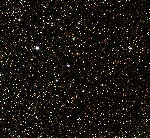 |
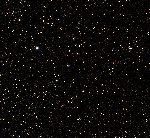 |
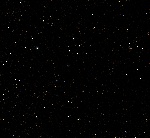 |
| Imax=2 | Imax=5 | Imax=25 |
SBIG ST-4K, 1200s total exposure 9/28/19 Lake San Antonio, CA
NGC 6804 is a planetary nebula in Aquila, not far from Altair. It shows a faint outer shell, a brighter inner shell, and a blue central star.
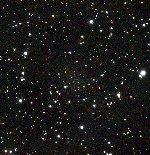 |
| Imax=0.25 |
SBIG ST-4K, 4500s total exposure 9/28/19 Lake San Antonio, CA
Andromeda I is one of a number of satellite galaxies of our galactic neighbor M31 (the Andromeda Galaxy). According to Wikipedia, it was discovered only in 1970. Since it was much too faint to see visually, I found it by star hopping, using the chart in Sky Safari. Even in a 5-minute exposure it was difficult to tell if the image contained anything other than stars. Here, the galaxy is visible as a faint but perceptible glow in the center of the image.
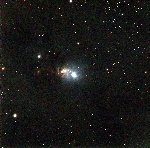 |
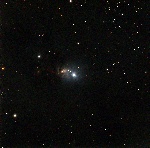 |
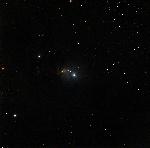 |
| Imax=0.50 | Imax=1 | Imax=2 |
SBIG ST-4K, 2100s total exposure 9/28/19 Lake San Antonio, CA
NGC 1333 in Perseus is mainly a reflection nebula, but it contains some other striking features that resemble eggs with red dots inside, apparently related to new star formation. These features barely came out in 35 minutes of exposure, but this nebula is so unusual that I may need to try capturing it again when I have a more automated system.
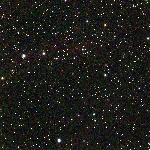 |
| Imax=1 |
SBIG ST-4K, 300s total exposure 9/25/19 Lake San Antonio, CA
This was a single-frame attempt to see a supernova remnant in Taurus labeled as "S147" in the Wil Tirion sky atlas. The map shows it covering a large area, and my pointing was not very precise. A few faint whisps appeared in the frame, but since the signal was quite weak, and it was almost 4am, I thought it best to save this object for another night.
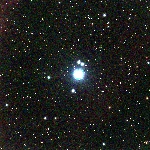 |
| Imax=1 |
SBIG ST-4K, 300s total exposure 9/25/19 Lake San Antonio, CA
Based on an image I saw (perhaps on Sky Safari) I was hoping to see some faint nebulosity near σ Orionis (a star slightly below the left side of Orion's belt). However, in 5 minutes exposure, only the faintest hint was visible except for a nebulous patch in the upper-left corner, which is probably part of IC434 (which is connected with the Horsehead Nebula).